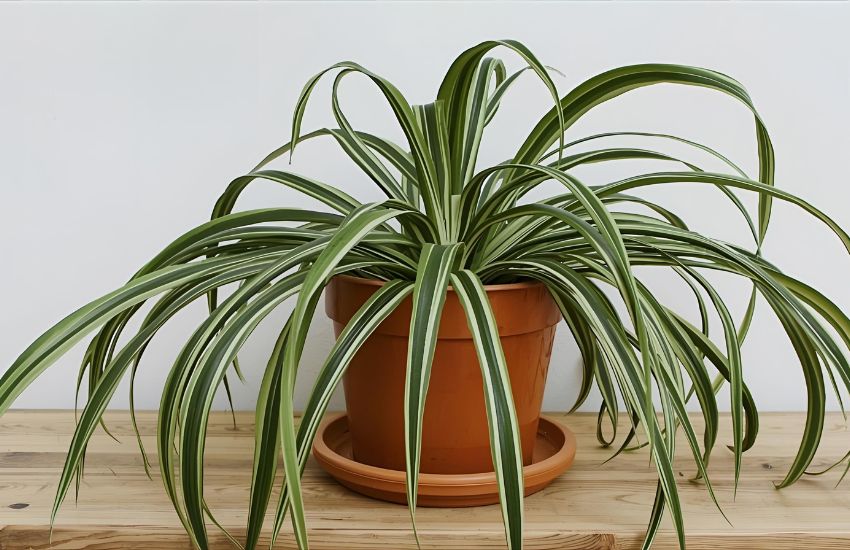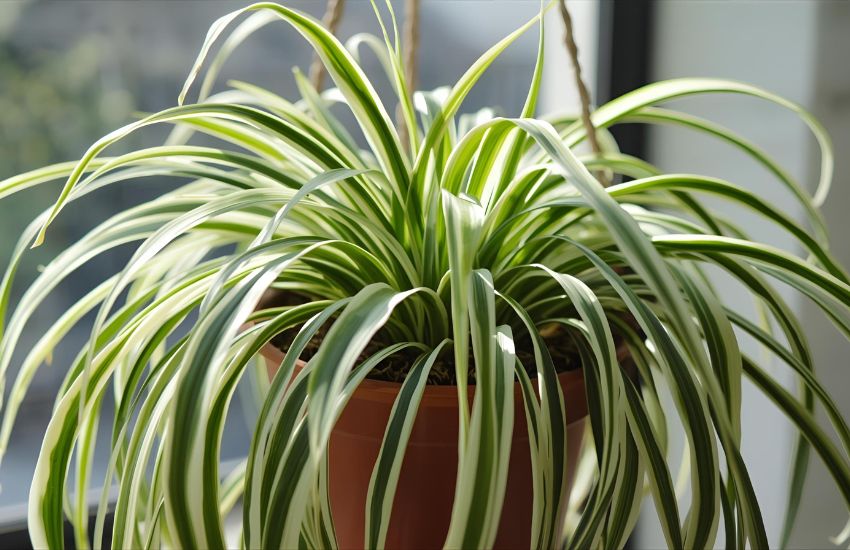The graceful arch of striped green leaves often makes you stop and admire the beauty of a spider plant. Known scientifically as chlorophytum comosum, this timeless favorite has earned its place as one of the most rewarding indoor companions. Its elegant stripe patterns and adaptable growth habits make it more than just a decorative choice—you find in it a resilient houseplant that thrives even when conditions are less than perfect.
The Chlorophytum Spider Plant is a hardy, variegated houseplant admired for its arching green-and-white striped leaves. Thriving indoors, it prefers bright, indirect light and well-draining soil. Water moderately, allowing soil to dry slightly between waterings. Propagation is simple—use plantlets or cuttings to grow new plants. This low-maintenance beauty enhances air quality while adding natural charm.
In this guide, you will learn how to grow and care for chlorophytum comosum, the best ways to propagate from plantlets, and how to keep its foliage vibrant while avoiding problems such as leaf tips turning brown. You will also discover care essentials for hanging baskets, humidity preferences, and the right strategies for healthy growth indoors.
How to Grow Chlorophytum Spider Plant Indoors for Lush, Healthy Growth

The Chlorophytum comosum, more commonly known as the airplane plant or spider plant, is celebrated as one of the most easy to grow indoor varieties. This house plant not only adds charm with its arching spider plant leaves, but also works as an air-purifying natural décor piece, improving your indoor air quality while being an attractive plant for any room.
Choosing the Right Variety
When selecting a spider plant, you will often come across cultivars like ‘vittatum’ with white stripes down the center or ‘variegatum’ with striking edge stripes. Both types display beautiful variegation, making them ideal as statement plants that can be easily grown indoors.
Potting and Soil Needs
For best results, spider plants grow well in a light, well-draining potting soil or a high-quality potting mix. Because the roots are thick and slightly fleshy, they store water, allowing the plant to tolerate occasional neglect. To avoid damage such as brown leaf tips, steer clear of water high in fluoride, as this mineral is often linked to leaf discoloration.
Light and Placement
Place your variegated spider plant in bright light, but protect it from harsh direct sun that may scorch the delicate leaves. A softly lit window is ideal to keep the variegation vibrant and healthy.
Watering and General Care
Keep the soil lightly moist but never waterlogged. Over time, you may notice small white flowers that give way to baby spider offshoots. These plantlets remain attached to the mother plant until they are ready for propagation, ensuring you always have new generations to enjoy.
Why Spider Plants Stand Out
Whether you choose to keep them in hanging baskets or tabletop pots, spider plants remain a versatile and reliable choice. Their natural resilience, ability to adapt, and air-purifying benefits make them one of the most rewarding plants to grow. With proper attention to water, light, and soil, your airplane plant will thrive as a lush, vibrant feature in your indoor space.
Choose the Right Pot and Fertilizer for Your Spider Plant

Selecting the right pot and fertilizer is essential if you want to help your spider plant thrive. Because this plant needs space for its roots to expand, choose a pot with proper drainage holes that allow excess water to escape easily. A well-drained container filled with a well-draining potting mix ensures the roots stay healthy and prevents the risk of rot. Spider plants adapt well to containers indoors, but they can also be grown outdoors in mild climates where conditions are suitable. Whether you choose the popular ‘vittatum’ or the striking ‘variegatum’ variety with green leaves with white margins, the right potting setup is the foundation for lush growth.
When it comes to watering, avoid using tap water that contains chemicals harmful to the plant, such as fluoride, which may cause damage over time. Instead, using collected rainwater can support healthier leaves, especially in areas with low humidity. Allow the top layer of soil to become slightly soil dry before watering again, as this mimics the plant’s natural environment.
Fertilizing is equally important, but too much fertilizer can harm the plant rather than support it. A balanced liquid fertilizer applied lightly during the active growing season will provide enough nutrients to strengthen the stalk and encourage new offshoots. As your spider plant produces baby plantlets, you can let them remain still attached to the mother until strong enough to pot separately. This is a rewarding way to grow and propagate and expand your collection. With the right balance of care, placement in indirect sunlight, and proper fertilization, you can successfully grow spider plants that remain vibrant and full of life year-round.
Conclusion
The spider plant is an excellent choice for both beginners and experienced plant lovers, thanks to its resilience and beauty. Its graceful arching leaves, often green and white, and plantlets that resemble spiders make it a striking addition to any home. With proper care—such as placing it in bright indirect light, allowing the soil to dry slightly between waterings, and using fertilizer at half strength during the active growing season—your plant will flourish for years.
Be mindful of issues like tip browning, tip burn, or leaves turning brown, which often result from overwatering, dry soil, or excess fertilizer. Since spider plants store water in their tuberous roots, they are forgiving if you occasionally forget a watering. Still, consistent care will prevent problems like root rot and ensure strong, vibrant growth. In the right environment, spider plants can reach up to 2 feet long, producing flower stalks with tiny white flowers, sometimes even star-shaped flowers, carried on long stems. These blossoms may lead to fewer plantlets at times, but healthy growth and new leaves will always follow during the growing period.
This adaptable plant thrives in average humidity, works beautifully in hanging baskets or as a tabletop accent, and can also be grown outdoors in mild climates. Watching baby plantlets form and developing roots while still attached to their flower stalks is one of the most rewarding parts of spider plant care.
Start your journey today—bring home a spider plant, give it the care it deserves, and enjoy its air-purifying beauty as it grows into a lush, timeless companion for your indoor or outdoor space.
Frequently Asked Questions (Chlorophytum Spider Plant: Grow and Propagate This Variegated Houseplant Indoors)
Is spider plant available in Pakistan?
Yes, spider plants (Chlorophytum comosum) are available in Pakistan and are quite popular as indoor and outdoor decorative plants. They are commonly found in nurseries across major cities like Karachi, Lahore, and Islamabad. Known for their air-purifying qualities and easy care, spider plants thrive well in Pakistan’s climate with proper light and watering.
How do you grow spider plants indoors?
To grow spider plants indoors, place them in bright, indirect light with moderate temperatures. Use well-draining soil and water when the top inch feels dry, avoiding soggy roots. Mist occasionally to maintain humidity. Fertilize monthly during spring and summer. Repot when roots crowd the pot, and trim brown tips to keep the plant healthy.
Where is the best place to put a spider plant indoors?
The best place to put a spider plant indoors is in bright, indirect light near an east- or north-facing window. Avoid direct sunlight, as it can scorch the leaves. Spider plants also thrive in moderate temperatures and slightly humid conditions, making living rooms, kitchens, or bathrooms ideal spots. Ensure proper drainage for healthy growth.
Is spider plant lucky for home?
Yes, a spider plant is considered lucky for homes as it symbolizes prosperity, positivity, and protection. It is believed to attract good energy while purifying indoor air by removing toxins. Many cultures associate it with harmony and growth, making it a popular choice for households seeking both aesthetic appeal and positive vibes.
